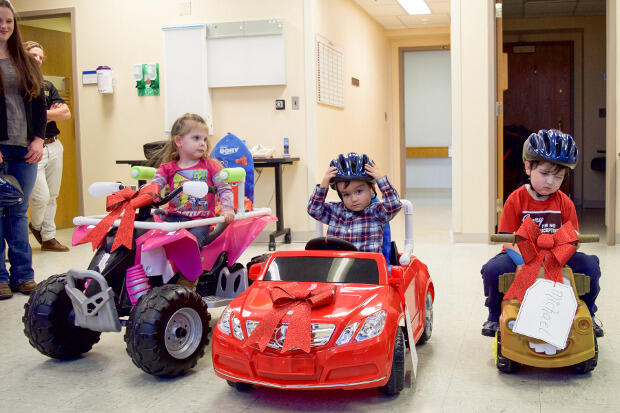
Dec. 22, 2016
Go Baby Go program gives children with mobile impairment a new independence
Share this story
"Car! Car!"
For a week, that was the word 2-year-old Harrison Price repeated over and over to his family.
“He’s been so excited because he knew he would be getting his car soon,” said Margaret Price, his mother.
Harrison received the battery-operated ride-on car, a Lightning McQueen Fisher-Price Power Wheel, on Dec. 9 from physical therapists at Children’s Hospital of Richmond at Virginia Commonwealth University as part of the Go Baby Go program. The car had been modified and adapted to meet Harrison’s specific mobility needs. Three other patients also received their cars that day.
The CHoR physical therapy program began the Go Baby Go program on limited grant funds. The grant allowed for four cars to be bought and individually modified for each patient, as well as for two other cars — one sitting and one standing version — to be used by patients during physical therapy sessions. Peter Pidcoe, D.P.T., Ph.D., associate professor and assistant chair in the Department of Physical Therapy, VCU School of Allied Health Professions, led the modification aspect of the project with students from the School of Engineering. The cars and materials were bought with grant funds, but the vehicles were assembled and modified with volunteer hours.
<slideshow id=156 align=center width=450>
Go Baby Go was developed in 2006 by VCU physical therapy program alumnus Cole Galloway, Ph.D., current director of the Pediatric Mobility Lab and Design Studio and professor at the University of Delaware, and Sunil Agrawal, Ph.D., director of Robotics and Rehabilitation Laboratory and Robotic Systems Engineering Laboratory at Columbia University. The goal of the program is to make power mobility more accessible to the 1-to-3-year-old patient population with significant mobile impairment to maximize their exploratory ability and independence.
Harrison was born with arthrogryposis, a condition that causes joint contractures, which means that some of the joints do not move as much as normal or may be stuck in one position. The Go Baby Go cars help Harrison and children with similar conditions get around on their own, establish some independence, play with their friends and just be a kid.
Research suggests that power mobility use can be beneficial in children as young as 18 to 20 months old. However, current power mobility options, such as power wheelchairs, are very expensive, heavy and bulky in child-sized environments and offer limited eye-to-eye interaction with children their own age. In addition, it is very difficult to get funding or to justify to an insurance company that a young child needs a power wheelchair when it might take them a few years to master it and use it to its full capabilities.
Mobility is so important to peer interaction, cognitive development and to increasing motor skills.
“Mobility is so important to peer interaction, cognitive development and to increasing motor skills,” said Lucille O’Neil, physical therapist at Children’s Hospital of Richmond at VCU. “Go Baby Go gets kids using independent mobility that’s appropriated in the classroom and in the home earlier. It gets them exploring their environment earlier and they’re able to have that cognitive facilitation of exploring on their own that doesn’t occur when a parent is carrying them from place to place.”
“It also helps with peer interaction,” O’Neil said. “At daycare while kids are out on their tricycles, they can be out on these cars. All of the kids can be playing together in a very inclusive environment. That’s the goal — to maximize the inclusiveness in everything these kids do.”
Currently, the program modifies ride-on cars, such as the Lightning McQueen or Barbie Fisher-Price Power Wheels, and adapts the wiring and integrates switches and safety equipment to create modified power mobility. Two types of cars have been developed: a seated option that can be used with a proportional joy stick or switch options and a standing version that works based on weight-shifting. These cars are light, more easily transported, child-friendly and place their drivers at eye-level with their peers allowing for better socialization.
For Harrison, he’s just happy that he can get outside and play with his older sisters.
“He really loves his car,” Margaret Price said. “He constantly wants to go out on his ‘car.’ He also wants to bring it ‘home,’ which means ride it in the house rather than outside. This has been really great for his speech as well. He can spend hours outside in the car and feels so proud to wave at the neighbors and show it off. He loves to race his sisters and turn in circles. It has been such a gift and we feel so lucky and thankful that he was part of the program.”

Subscribe for free to the weekly VCU News email newsletter at http://newsletter.news.vcu.edu/ and receive a selection of stories, videos, photos, news clips and event listings in your inbox every Thursday.
Subscribe to VCU News
Subscribe to VCU News at newsletter.vcu.edu and receive a selection of stories, videos, photos, news clips and event listings in your inbox.











